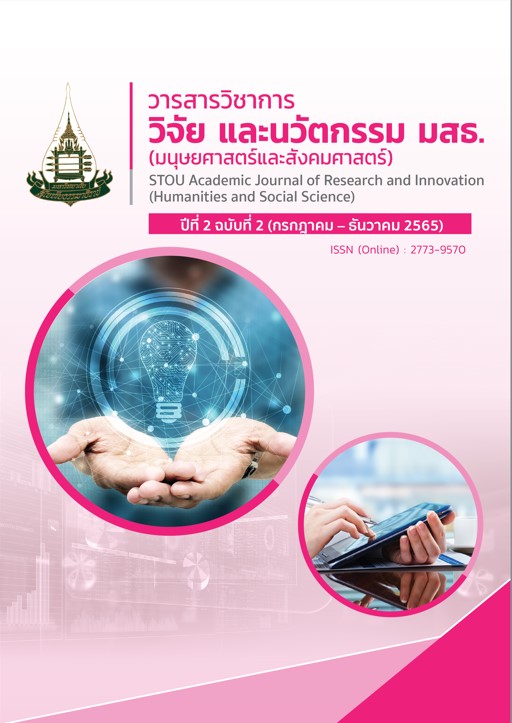Strategic Development of Thai Higher Education Institutions (HEIs) with the Sustainability Balanced Scorecard
Keywords:
Strategy, Sustainability Balanced Scorecard, Thai Higher Education InstitutionsAbstract
The process of developing a strategic plan for Thai higher education institutions (HEIs) often uses the SWOT Analysis tool to analyze the environment, followed by the TOWS Matrix in the analysis to develop a strategy with strategic issues according to the Higher Education Standards 2018, which include five standards: 1) learner outcome 2) research and Innovation 3) academic service 4) arts and culture, as well as being Thai and 5) management However, the Ministry of Higher Education, Science, Research and Innovation has released a new standard, titled Higher Education Management Standards 2022, which includes specifics on the standards for the implementation of quality HEIs in order to achieve success in line with the stated vision and report on important results. This is in accordance with the Education Criteria for Performance Excellence (EdPEx) guidelines 2020-2023, as well as Thai HEIs aiming for sustainable outcomes with an assessment system based on development guidelines that as a result of the sustainability of THE Impact Ranking for all 17 SDGs. Therefore, Thai HEIs should consider adopting the concept of the Sustainability Balanced Scorecard (SBSC) combines the Balanced Scorecard (BSC) concept developed by Kaplan & Norton in 1996 with the Triple Bottom Line (TBL) concept developed by John Ellington in 1997 to ensure that HEIs have a stable financial position through the Office of Sustainability Management (OSM), and it was used to manage a sustainability direction in HEIs covering four perspectives: 1) Sustainability 2) Stakeholders 3) Internal Processes and 4) Learning and Development.
References
เทื้อน ทองแก้ว. (2555). สำนักงานบริหารยุทธศาสตร์: กลไกสำคัญในการขับเคลื่อนกลยุทธ์ที่มีประสิทธิภาพในการบริหารการเปลี่ยนแปลงสถาบันอุดมศึกษา. ACADEMIC JOURNAL BANGKOKTHONBURI UNIVERSITY, 1(2), 1-20.
ธีรเสฏฐ์ ศิรธนานนท์. (2564). ยุทธศาสตร์การพัฒนาสถาบันอุดมศึกษาแห่งเมืองสำหรับสถาบันอุดมศึกษาในกำกับองค์กรปกครองส่วนท้องถิ่นรูปแบบพิเศษ. ปริญญานิพนธ์ กศ.ด. (การจัดการการอุดมศึกษา). กรุงเทพฯ: บัณฑิตวิทยาลัย มหาวิทยาลัยศรีนครินทรวิโรฒ.
พระราชบัญญัติการศึกษาแห่งชาติ พ.ศ. 2542. (2542, 19 ธันวาคม). ราชกิจจานุเบกษา (เล่มที่ 116 ตอนที่ 74ก, น. 12-13).
ไพบูลย์ โพธิ์สุวรรณ. (2552). แนวคิดการบริหารเชิงยุทธศาสตร์. วารสารดำรงราชานุภาพ, 9(31), 12-26.
มาตรฐานการจัดการศึกษาระดับอุดมศึกษา พ.ศ. 2565. (2565). ราชกิจจานุเบกษา (เล่มที่ 139 ตอนที่ 20ก, น. 8-9).
สำนักงานคณะกรรมการการอุดมศึกษา. (2558). คู่มือการประกันคุณภาพการศึกษาภายใน ระดับอุดมศึกษา พ.ศ.2557 (พิมพ์ครั้งที่ 3). กรุงเทพฯ: ภาพพิมพ์.
สำนักงานสภาพัฒนาการเศรษฐกิจและสังคมแห่งชาติ. (2563). ตัวชี้วัดการพัฒนาระดับจังหวัดและกลุ่มจังหวัด. กรุงเทพฯ: สำนักงานสภาพัฒนาการเศรษฐกิจและสังคมแห่งชาติ.
สำนักงานสภาพัฒนาการเศรษฐกิจและสังคมแห่งชาติ. (2565). เกี่ยวกับ SDGs. สืบค้นจาก https://sdgs.nesdc.go.th/เกี่ยวกับ-sdgs/
Dias Sardinha, I., Reijnders, L., & Antunes, P. (2003). From environmental performance evaluation to eco-efficiency and sustainability balanced scorecards. Environmental Quality Management, 12(2), 51-64.
Hansen, E. (2010). Responsible Leadership Systems: An Empirical Analysis of Integrating Corporate Responsibility into Leadership Systems. (Doctoral dissertation). Johannes Kepler University, Linz, Austria.
Kaplan, R. S., & Norton, D. P. (1996). The Balanced Scorecard: Translating Strategy into Action. Boston: Harvard Business School Press. (Nominated for Financial Times/ Booz-Allen & Hamilton Global Business Book Award presented by Booz-Allen & Hamilton. Winner of Notable Contribution to Management Accounting Literature Award presented by American Accounting Association.).
Norton, D. P., & Russell, R. H. (2009). Linking Strategy to operations: Part II-Theme Teams and IT Infrastructure. Balanced Scorecard Report, 11(5), 1-6.
Time Higher Education. (2022). Impact Rankings 2022. Retrieved from https://www.timeshighereducation.com/impactrankings#!/page/0/length/25/locations/THA/sort_by/rank/sort_order/asc/cols/undefined
Weihrich, H. (1982). The TOWS matrix—A tool for situational analysis. Long Range Planning, 15(2), 54-66.
Downloads
Published
How to Cite
Issue
Section
License
Copyright (c) 2022 STOU Academic Journal of Research and Innovation (Humanities and Social Science) (Online)

This work is licensed under a Creative Commons Attribution-NonCommercial-NoDerivatives 4.0 International License.





